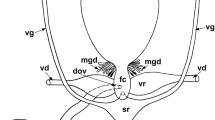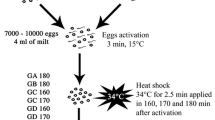Summary
-
1.
The germ cells of the hermaphrodite embryos ofIcerya purchasi contain the diploid number of chromosomes (four) from the time of the first segregation of the germ cells up to the time of the emergence of the nymphs from the eggs.
-
2.
During the early part of the first nymphal instar, usually before the attachment of the nymph to the host plant has occurred, haploid nuclei appear among the diploid nuclei of the gonad.
-
3.
The chromosomes of these haploid nuclei are recognisable by size and shape as comprising one member of each pair of the diploid chromosome complex. It follows that a reduction from the diploid to the haploid condition has taken place, but no evidence on the cytological mechanism underlying this reduction is available.
-
4.
The haploid nuclei usually give rise to the central core of the gonad and often to a variable amount of more or less isolated lateral masses of tissue. From this haploid tissue the spermatozoa of the hermaphrodite gonad are derived.
-
5.
In the spermatogenesis only one meiotic division occurs. This is equational in character. The processes of spermatogenesis correspond exactly with those described for the haploid males of this species.
-
6.
In two aberrant cases spermatids were produced from diploid cells. Two divisions were undergone and reduction to the haploid state accomplished, although without synapsis. Cytology of these aberrant cases is incomplete.
-
7.
The diploid nuclei of the gonad proliferate slowly throughout the male phase, and usually come to form the outer or peripheral zone of the young gonad. The diploid nuclei give rise to the follicular epithelium of the gonad, the egg cells, the nurse cells, and to the greater part of the interstitial tissue of the gonad.
-
8.
Oogonia are differentiated from the primary diploid germ cells by a peculiar type of mitosis which involves the formation of a continuous spireme and its early longitudinal splitting. The split spireme segments into four lenghts which condense to form the chromosomes. This type of mitosis is restricted to the early proliferation of oogonia and to the three divisions of each oogonium by means of which the eight cells (seven nurse cells and one egg) of each ovariole are produced.
-
9.
Coincident with or slightly before the first appearance of haploid nuclei in the hermaphrodite gonad, degeneration of certain germ cell nuclei occurs. This continues to a variable extent throughout the development of the gonad and is particularly evident in regions where haploid and diploid nuclei meet, in diploid regions during the male phase, and in haploid regions during the diploid or female phase of the gonad. With the final establishment of the female phase degeneration usually ceases. Evidence is given that this nuclear disintegration is not directly involved in the original reduction of the spermatogonial-mother cells.
-
10.
InIcerya purchasi collected at various places, including one collection from Italy, the same types, diploid hermaphrodites and haploid males, are present as in the American stock first described. No pure females have been found.
-
11.
Breeding data indicate that separate strains or races differing in respect to the presence or absence of the facultative parthenogenesis by means of which the haploid males are produced, do not exist.
Similar content being viewed by others
Literature cited
Bashford, E. F. andMurray, J. A. (1905): On the occurrence of heterotypical mitoses in cancer. Proc. of the Roy. Soc. of London (B)77.
Farmer, J. B., Moore, J. E. S., andWalker, C. E. (1903): On the resemblances exhibited between the cells of malignant growths in man and those of normal reproductive tissues. Ibid.72.
- Id. (1905): On the cytology of malignant growths. Ibid.77.
Goldschmidt, R. (1923): The mechanism and physiology of sex determination. New York: Geo. H. Doran Co.
- Id. (1926): Bemerkungen zum Problem der Geschlechtsbestimmung beiBonnellia. Biol. Zentralbl.46.
v. Hangemann, D. (1904): Über Kernteilungsfiguren in bösartigen Geschwülsten. Ibid.24.
- Id. (1905): Einige Bemerkungen über die angeblich heterotypen Zellteilungen in bösartigen Geschwülsten. Ibid.25.
Hughes-Schrader, S. (1925): Cytology of hermaphroditism inIcerya purchasi (Coccidae). Zeitschr. f. wiss. Biol., Abt. B: Zeitschr. f. Zellforsch. u. mikroskop. Anat.2.
- Id. (1926): Spermatogenesis inIcerya purchasi — a correction. Science63.
Kemp, H. P. (1910): On the question of occurrence of “heterotypic reduction” in somatic cells. Ann. of Botany24.
Kuwana, I. (1922): Studies on Japanese Monophlebinae. I. The genusWarajicoccus. Dept. of the Agricult. a. Com. Imp. Plnt. Quar. Sta., bull. 1. (Japan.)
Metz, C. W., Moses, M. S., andHoppe, E. N. (1926): Chromosome behavior and genetic behavior inSciara (Diptera). I. Chromosome behavior in the spermatocyte divisions. Zeitschr. f. indukt. Abstammungs- u. Vererbungslehre42.
Nemec, B. (1904): Über die Einwirkung des Chloralhydrats auf die Kern- und Zellteilung. Jahrb. f. wiss. Botanik39.
- Id. (1909): Zur Mikrochemie der Chromosomen. Ber. d. dtsch. botan. Ges.27.
Pierantoni, U. (1912): Studio sullo sviluppo d'Icerya purchasi Mask. Parte I. Origine ed evoluzione degli elementi sessuale femminili. Arch. di Zool. Ital.5.
- Id. (1914a): The same. Parte 2. Origine ed evoluzione degli organi sessuale maschili. Ermafroditismo. Ibid.7.
- Id. (1914b): The same. Parte 3. Osservazioni di embriologia. Ibid.7.
Schrader, F. (1923): A study of the chromosomes in three species ofPseudococcus. Arch. f. Zellforsch.17.
Schrader, F. andHughes-Schrader, S. (1926): Haploidy inIcerya purchasi. Zeitschr. f. wiss. Zool.128.
Stebbing, J. O. (1904): On the life history of a newMonophlebus from India. Journ. of the Linnean Soc. of London29.
Strasburger, E. (1907): Über die Individualität der Chromosomen und die Pfropfhybridenfrage. Jahrb. f. wiss. Botanik44.
- Id. (1909): Meine Stellungsnahme zur Frage der Pfropfbastarde. Ber. d. dtsch. botan. Ges.27.
Thomson, M. (1927): Studien über die Parthenogenese bei einigen Cocciden und Aleurodiden. Zeitschr. f. wiss. Biol., Abt. B: Zeitschr. f. Zellforsch. u. mikroskop. Anat.5.
Winkler, H. (1910a): Über die Nachkommenschaft derSolanum-Pfropfbastarde und die Chromosomenzahlen ihrer Keimzellen. Zeitschr. f. Botanik2.
- Id. (1910b): Über das Wesen der Pfropfbastarde. Ber. d. dtsch. botan. Ges.28.
- Id. (1916): Über die experimentelle Erzeugung von Pflanzen mit abweichenden Chromosomenzahlen. Zeitschr. f. Botanik 8.
Author information
Authors and Affiliations
Rights and permissions
About this article
Cite this article
Hughes-Schrader, S. Origin and differentiation of the male and female germ cells in the hermaphrodite of Icerya purchasi (coccidae). Z.Zellforsch 6, 509–540 (1928). https://doi.org/10.1007/BF01266624
Received:
Issue Date:
DOI: https://doi.org/10.1007/BF01266624




